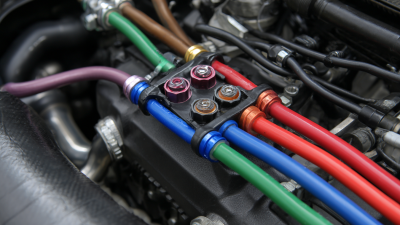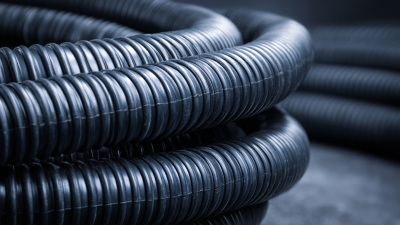The rubber air hose industry is poised for significant growth and innovation in the coming years, driven by advancements in materials science and increased demand from various sectors. According to a recent market research report from Grand View Research, the global rubber air hose market is projected to reach approximately $1.5 billion by 2027, expanding at a CAGR of 4.8% from 2020. This growth is largely attributed to the rising usage of rubber air hoses in automotive, construction, and manufacturing applications, where durability and flexibility are paramount. As we look to 2024 and beyond, emerging technologies such as enhanced formulations and eco-friendly production processes are set to revolutionize the rubber air hose market, offering new opportunities for manufacturers and end-users alike. In this blog, we will explore the anticipated innovations and market growth projections for rubber air hoses, providing valuable insights and practical tips for stakeholders navigating this evolving landscape.

The rubber air hose market is experiencing significant advancements, driven by innovative technologies and increasing demand across various sectors. According to recent reports, the overall hoses market is projected to grow from USD 12.28 billion in 2023 to USD 28.25 billion by 2032, achieving a robust compound annual growth rate (CAGR) of 9.7%. This growth highlights the critical role that rubber air hoses play in a variety of applications, from industrial uses to automotive and fluid transfer systems.
Current trends indicate that advancements in material science and manufacturing processes are enhancing the performance and durability of rubber air hoses. The industrial hose market, in particular, is expected to expand, with forecasts suggesting it will reach USD 13.92 billion by 2030, driven by the increasing demand for high-quality, resilient hoses capable of withstanding intense operating conditions. Furthermore, as industries shift toward lightweight and high-performance materials, the adoption of rubber air hoses is likely to grow, imposing new standards of efficiency and reliability in fluid transfer applications.
The rubber air hose industry is poised for significant transformation, driven by key innovations that promise to enhance durability and performance. According to a recent market analysis by Grand View Research, the global rubber hose market is expected to grow at a CAGR of 4.3% from 2024 to 2030, highlighting the increasing demand across several sectors, including automotive and construction. One innovation gaining traction is the integration of advanced polymer technology, which offers superior flexibility and resistance to abrasion, making hoses not only longer-lasting but also easier to handle in various environments.
In addition to material enhancements, the advent of smart technology in rubber air hoses is reshaping operational efficiency. Manufacturers are now developing hoses equipped with sensors that monitor pressure levels and detect wear in real time, minimizing downtime and maintenance costs. This type of proactive approach is expected to significantly reduce equipment failure rates, according to a report by MarketsandMarkets, which notes that implementing smart solutions can improve operational timelines by up to 30%.
Tips for consumers looking to invest in rubber air hoses include considering compatibility with existing equipment, evaluating the hose's temperature resistance, and checking if the design integrates any innovative features like anti-kink technology. Additionally, opting for hoses with a warranty can provide extra assurance of quality and performance over time. Embracing these innovations can lead to significant efficiency gains in various applications, ultimately driving growth in the industry.

As we look ahead to 2024 and beyond, the rubber air hose market is projected to witness significant growth driven by various factors, including technological advancements and increasing industrial demands. With a surge in construction and manufacturing activities globally, the need for durable and high-performance air hoses is greater than ever. Innovations in materials and designs are key contributors to this growth, enabling air hoses to handle higher pressures and providing enhanced flexibility, which in turn improves overall efficiency and safety in various applications.
Moreover, sustainability is becoming an integral part of market dynamics. Manufacturers are exploring eco-friendly materials and production techniques to meet the growing demand for green products. The shift towards more sustainable solutions is not only a response to changing regulations but also aligns with consumer preferences for environmentally responsible products. As we dive deeper into the coming years, stakeholders in the industry must be prepared to adapt to these trends to capitalize on the emerging opportunities within the rubber air hose market.
The production of rubber air hoses is undergoing a significant transformation as sustainability becomes a primary focus in the manufacturing process. As environmental concerns rise, manufacturers are investing in materials and techniques that reduce waste and energy consumption. Innovations such as the use of recycled rubber and bio-based materials are not only minimizing the carbon footprint but also enhancing the performance of these hoses. Companies are beginning to prioritize eco-friendly alternatives, which are becoming increasingly popular among consumers who recognize the importance of sustainable choices.
Moreover, the impact of sustainable practices extends beyond production to include end-of-life considerations for rubber air hoses. Manufacturers are developing programs for recycling and repurposing old hoses, helping to keep them out of landfills. This shift towards a circular economy is not just beneficial for the environment; it also presents new market opportunities. Consumers are more inclined to support brands that demonstrate social responsibility, leading to potential growth in market shares for those who commit to sustainability. As we move toward 2024 and beyond, the convergence of innovation and sustainability is set to redefine the rubber air hose market, paving the way for a greener future.

The rubber air hose market is on the brink of significant transformation, driven by both challenges and opportunities. As industries evolve, the demand for durable and efficient air hoses has surged. Manufacturers are faced with the challenge of meeting strict industry standards while simultaneously adopting sustainable practices. Innovations in material technology and production processes can help overcome these hurdles, enabling companies to produce high-performance hoses that are both eco-friendly and cost-effective.
Moreover, the rising trend of automation and the growth of sectors such as construction, manufacturing, and automotive present lucrative opportunities for market expansion. As businesses seek to improve efficiency and reduce downtime, the need for reliable rubber air hoses becomes paramount. Companies that can leverage emerging technologies, such as smart hoses equipped with monitoring sensors, will likely lead the way in capturing a larger market share. The integration of digital solutions into traditional products represents a pivotal opportunity for growth, setting the stage for a dynamic evolution in the rubber air hose landscape.
| Year | Market Size (Million $) | Growth Rate (%) | Key Innovations | Challenges | Opportunities |
|---|---|---|---|---|---|
| 2024 | 1500 | 5.0 | Eco-friendly materials | Raw material price volatility | Emerging markets |
| 2025 | 1575 | 5.0 | Smart hose technology | Stringent regulations | Industrial automation |
| 2026 | 1650 | 4.8 | Lightweight design | Supply chain disruptions | Sustainability trends |
| 2027 | 1725 | 4.5 | Enhanced durability features | Technological adaptation | Collaboration with tech firms |
| 2028 | 1800 | 4.3 | Recyclable materials | Consumer preference shifts | Expansion into new industries |






